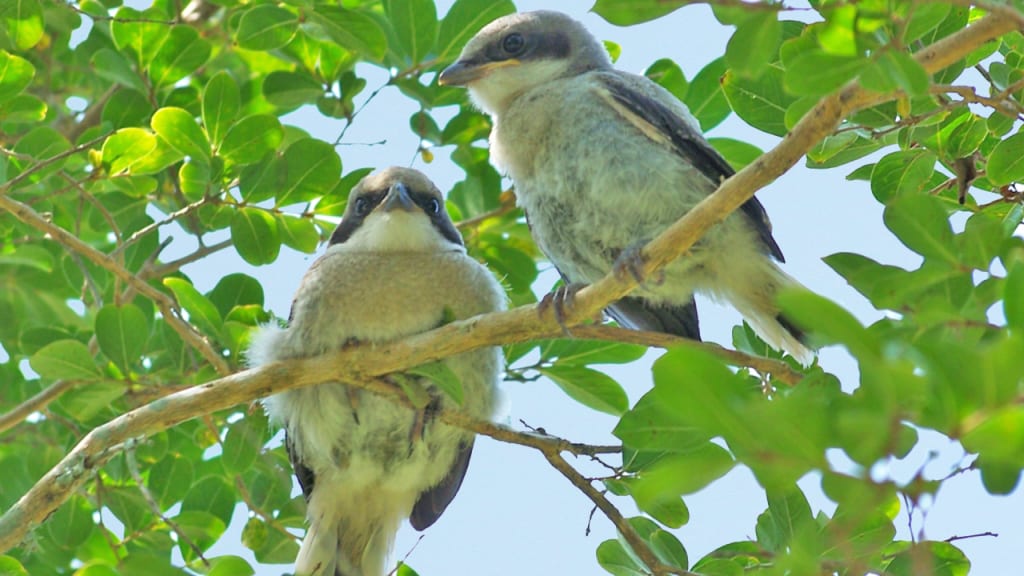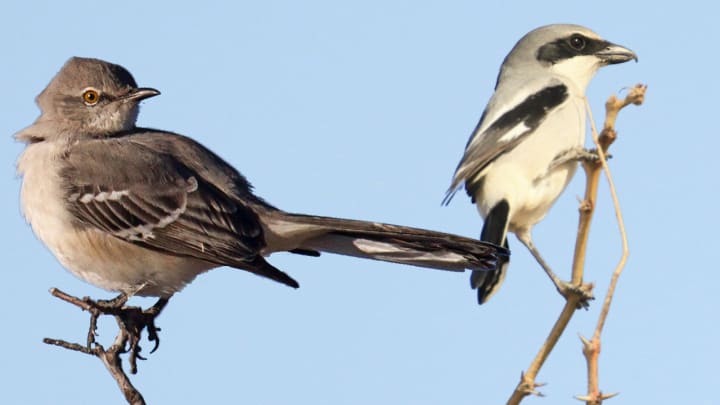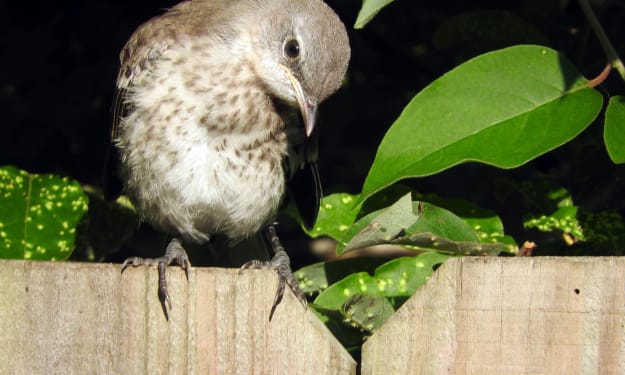Loggerhead Shrikes Might Be Lurking in a Parking Lot Near You
A pair of survivors bounce back to breed again

Some weeks ago, I spotted the official Loggerhead Shrikes of my grocery store parking lot. One of them was hard at work gathering spring nest material. A welcome sight.
I have a soft place in my heart for the so-called French Mockingbird. Sturdy gray birds in their bandit’s mask, they often seem to go unseen. Too many people see a gray bird out of the corner of their eye and write it off as a Northern Mockingbird.
No one else at the grocery store ever stops to look at our breeding pair. I sometimes feel like they’re my little secret.
Last year at that time, the parks were closed. Watching birds at the grocery store was as good as it got once I left my own yard. A grocery pick-up station was set up near the tree where the Shrikes nested in earlier years, but I didn’t find them there.
In that anxious time, I parked well away from everybody else near a different tree. So, apparently, did the Shrikes. On April 24, 2020, my diary tells how I spotted an angry Shrike striking a Gray Squirrel on the head:
“Not once, but multiple times, [the bird] even chased across the lanes to catch him and hit him again.”
An entertaining sight, especially at a time when entertainment was hard to come by. Still, I worried for the Shrikes. Did the bird’s fury mean the squirrel had destroyed an active nest?
Thankfully not. On my next grocery run a week later, I heard a fussing baby bird crying for food. When I checked the tree the Shrike had defended so ably, I spotted an adorable fledgling begging to be fed. A parent soon appeared.
On May 14, the fledglings were still there and still being fed. A happy ending. And now a new beginning, since the birds have returned for 2021.
Where to Find Shrikes — At Least For Now
In my town, if you wanted to call them parking lot birds, you wouldn’t be wrong. I’ve spotted nests at Fontainebleau State Park on the eastern side of Mandeville, Louisiana. More often, though, I’ve spotted them in parking lots. A pair sometimes works a certain strip mall. Another has a tree in a ditch near the abandoned convenience store.
You might enjoy checking such otherwise unpromising spaces for yourself. Birds of open grasslands, Shrikes adapt well enough to parking lots or scrubby abandoned lots. The species enjoys a wide range across North America, so you’ve got a decent chance of being somewhere you can find them.
Breeding populations living north of the 40th latitude do migrate south to avoid winter snow. However, large areas of the southern United States and much of Mexico host year-round residents.
In theory, they’re tough guys. Survivors. A powerful and opportunistic little predator that stashes high-protein prey like insects on the spike of thorns or a barbed-wire fence. They won’t turn up their hooked bill at a small frog or lizard either.

In reality, their survival is in doubt. According to the American Bird Conservancy, their population has collapsed almost 80% since 1966. This collapse probably tracks the collapse in worldwide insect populations, since their diet is so heavily insectivorous.
How To Identify a Loggerhead Shrike
Northern Mockingbirds and Loggerhead Shrikes are both bold gray birds often found in parking lots. The main reason people confuse them is they’re not looking in the first place. They assume they’re all Mockingbirds.

Once you’re actually looking instead of assuming, it’s pretty easy to tell the difference.
A Northern Mockingbird is a slim bird that swaggers about swishing its tail as if it’s on a ball-and-socket. There’s a hint of a dark line on the face, but hardly a mask.
A Loggerhead Shrike is sturdy with a bandit mask and a hooked bill. Less swagger and bluff. More quiet menace.
Report Banded Shrikes
As a sharply declining grassland species, the Loggerhead Shrike is being studied by researchers. If you spot a banded bird, dead or alive, please follow the detailed guide provided online by the Loggerhead Shrike Working Group.
Please note: Never approach too close to a breeding pair or active nest in your pursuit of band information or photographs. For this story, I chose to use the work of other photographers rather than get too close to nesting birds.
Photo Credits
Feature Photo: Loggerhead Shrike Fledglings by LJMacphee / CC-by-2.0
Center Photo: Young Shrike with Frog by Susan Young under CC PDM 1.0 license
Mocker vs. Shrike Collage: Northern Mockingbird by Larry Smith / CC-by-2.0 license / Loggerhead Shrike by Pamela Gunn / CC PDM 1.0 license / Collage by the author / Birds are not to scale and are placed together for field mark comparison only.
If you enjoyed this guide to Loggerhead Shrikes or found it useful, gently tap that <3 button. Tips gratefully accepted.
About the Creator
Amethyst Qu
Seeker, traveler, birder, crystal collector, photographer. I sometimes visit the mysterious side of life. Author of "The Moldavite Message" and "Crystal Magick, Meditation, and Manifestation."
https://linktr.ee/amethystqu






Comments
There are no comments for this story
Be the first to respond and start the conversation.